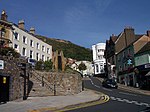Clarendon School for Girls
1898 establishments in the United Kingdom1992 disestablishments in the United KingdomDefunct girls' schools in the United KingdomPeople educated at Clarendon School for GirlsUse British English from February 2023
Clarendon School for Girls was a girls' independent boarding school, which began in 1898 in Malvern, Worcestershire, England. It moved three times: first to Kinmel Hall near Abergele in Denbighshire in 1948 and then to Haynes Park in Bedfordshire in 1976 before merging with Monkton Combe School, near Bath, Somerset in 1992.
Excerpt from the Wikipedia article Clarendon School for Girls (License: CC BY-SA 3.0, Authors).Clarendon School for Girls
North Malvern Road, Malvern Hills North Malvern
Geographical coordinates (GPS) Address Nearby Places Show on map
Geographical coordinates (GPS)
| Latitude | Longitude |
|---|---|
| N 52.120586 ° | E -2.334055 ° |
Address
North Malvern Road
North Malvern Road
WR14 4LX Malvern Hills, North Malvern
England, United Kingdom
Open on Google Maps











